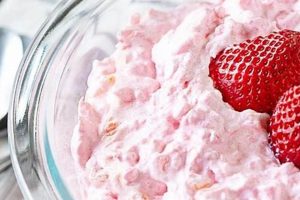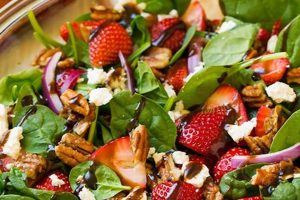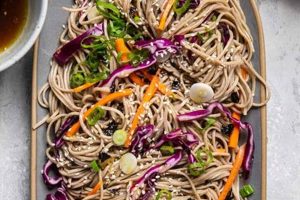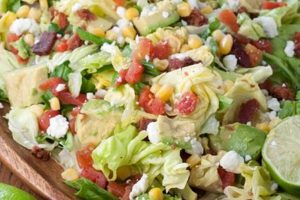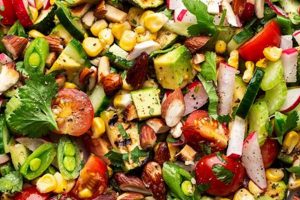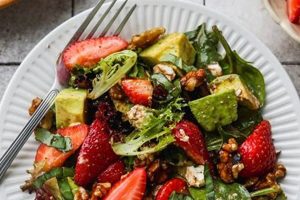A highly sought-after dessert, typically featuring chopped Snickers bars combined with whipped cream, pudding, apples, and often other ingredients like caramel or nuts, represents a popular treat, especially during holidays and potlucks. Variations exist, showcasing diverse ingredient combinations and preparation methods. For example, some versions might incorporate cream cheese, sour cream, or condensed milk, while others might prioritize specific apple varieties like Granny Smith for their tartness.
The appeal of this dessert lies in its balanced blend of sweet and tart flavors, creamy textures, and crunchy elements. Its ease of preparation contributes to its widespread popularity, making it an accessible dessert option for both novice and experienced cooks. Historically rooted in American cuisine, this dessert has evolved from simpler iterations to more complex variations reflecting changing culinary trends and regional preferences. The ongoing search for the ultimate version drives experimentation and adaptation, underscoring its enduring relevance in the culinary landscape.
This exploration will delve into optimal ingredient selection, detailed preparation techniques, creative variations, and effective presentation strategies to help achieve a truly exceptional result.
Tips for an Exceptional Snickers Salad
Achieving a truly satisfying dessert experience requires attention to detail and a strategic approach to ingredient selection and preparation. The following tips offer guidance for creating a standout dish.
Tip 1: Apple Selection is Key: Opt for firm, tart apples like Granny Smith. Their tartness balances the sweetness of the other ingredients, preventing an overly sugary result. Avoid softer apples, which may become mushy.
Tip 2: Proper Snickers Preparation: Chill the candy bars thoroughly before chopping to ensure clean cuts and prevent excessive sticking. A sharp knife is essential. Consider varying the chop size for textural interest.
Tip 3: Whipped Cream Considerations: Homemade whipped cream offers superior flavor and texture compared to pre-made alternatives. Ensure the cream is well-chilled before whipping to achieve optimal volume and stability.
Tip 4: Pudding Choice Matters: Vanilla pudding provides a classic base, but other flavors like caramel or butterscotch can complement the Snickers. Instant pudding is convenient, but cooked pudding offers a richer flavor and denser texture.
Tip 5: Balancing Sweetness: Taste and adjust sweetness as needed. If the apples are particularly tart, a touch of powdered sugar can be incorporated into the whipped cream. Conversely, if the pudding is very sweet, reduce the added sugar or caramel.
Tip 6: Enhancing Texture: Toasted, chopped nuts like pecans or walnuts provide a welcome crunch and depth of flavor. Consider adding a sprinkle of sea salt to enhance the sweet and salty contrast.
Tip 7: Chill Time is Crucial: Allowing the salad to chill for at least two hours before serving allows the flavors to meld and the textures to set, resulting in a more harmonious and enjoyable dessert.
By following these guidelines, one can elevate this simple dessert to a truly memorable culinary experience. Attention to detail and thoughtful ingredient selection are key to unlocking its full potential.
These insights provide a foundation for creating an exceptional dessert. The following section will offer variations and presentation suggestions to further enhance the final product.
1. High-Quality Ingredients
The pursuit of a superlative Snicker salad rests significantly on the selection of high-quality ingredients. Ingredient quality directly impacts the final flavor, texture, and overall enjoyment of the dish. Subpar ingredients can compromise the delicate balance of sweet and tart, creamy and crunchy, resulting in a less satisfying experience. For instance, using mealy apples instead of crisp, tart varieties can lead to a mushy texture and muted flavor. Similarly, opting for generic-brand candies might introduce a waxy texture and less intense chocolate flavor, diminishing the overall quality of the dessert.
The choice of fresh, flavorful ingredients elevates this simple dessert to a new level. Using real whipped cream, as opposed to aerosol varieties, contributes a richer, smoother texture and a cleaner flavor profile. Selecting premium vanilla extract enhances the complexity of the pudding base. Investing in high-quality Snickers bars ensures the optimal balance of chocolate, nougat, caramel, and peanuts, the hallmark of this beloved candy. These seemingly small choices compound to create a noticeable difference in the final product. Consider the difference between freshly-ground spices and pre-ground versions; the former offers a vibrancy and depth of flavor often lacking in the latter. This principle applies across all ingredients in a Snicker salad.
Prioritizing high-quality ingredients demonstrates a commitment to excellence. While substitutions may offer convenience or cost savings, they can compromise the integrity of the recipe. Understanding the impact of ingredient quality allows one to make informed decisions, ensuring the final product aligns with the desired outcome a truly exceptional Snicker salad. Ultimately, the pursuit of the best necessitates an investment in the best ingredients. This foundational principle underlies the creation of any truly exceptional dish, highlighting the crucial link between quality ingredients and a superior culinary result.
2. Precise Measurements
Precision in measurement plays a crucial role in achieving a consistently successful Snicker salad. This dessert relies on a delicate balance of flavors and textures. Incorrect measurements can disrupt this balance, leading to outcomes ranging from overly sweet to excessively tart, or from a runny consistency to an undesirably dense one. Consider the impact of using too much whipped cream: the salad might become overly rich and mask the other flavors. Conversely, too little whipped cream could result in a dry, less appealing dessert. The ratio of apples to other ingredients also requires careful consideration. Too many apples can overpower the sweetness of the Snickers and pudding, while too few can leave the salad lacking in textural contrast and refreshing tartness. Even seemingly minor variations in ingredient quantities can significantly alter the final product.
A real-life example illustrates this point. Imagine a recipe calling for one cup of chopped Snickers bars. Using a heaping cup instead of a level cup introduces extra sweetness and potentially throws off the balance between creamy and crunchy elements. Similarly, using a scant cup of apples when the recipe specifies a full cup reduces the tartness needed to counterbalance the sweetness of the other components. These seemingly small discrepancies can compound, resulting in a final product that deviates significantly from the intended result. Consistency in measurement ensures predictable outcomes, which is essential when striving for the best possible iteration of this dessert.
Understanding the importance of precise measurements empowers one to replicate successful outcomes reliably. It transforms a process dependent on guesswork into a controlled procedure with predictable results. This control is especially critical when preparing the dish for a special occasion or a large group, where consistency and quality are paramount. Precise measurements provide a framework for culinary success, enabling cooks to achieve the desired balance of flavors and textures consistently. Mastery of this fundamental principle forms a cornerstone of successful cooking and baking across various cuisines and recipes.
3. Proper Chilling Times
Proper chilling times constitute a critical factor in achieving a truly exceptional Snicker salad. This seemingly simple step profoundly influences the final texture, flavor melding, and overall enjoyment of the dessert. Insufficient chilling can result in a less cohesive dish with flavors that haven’t fully integrated, while excessive chilling may compromise textural elements.
- Flavor Development
Chilling allows the diverse flavors of the individual ingredientsthe chocolate and caramel of the Snickers, the tartness of the apples, the sweetness of the pudding, and the richness of the whipped creamto meld and harmonize. This fusion creates a more complex and nuanced flavor profile than would be achieved if the ingredients were simply combined and served immediately. Similar to marinating meats, where time allows the marinade to penetrate and enhance the flavor, chilling a Snicker salad allows the individual components to infuse the overall dish with their respective characteristics.
- Texture Enhancement
Chilling firms the whipped cream, preventing it from becoming runny or deflated. It also allows the apples to maintain their crispness, providing a pleasant textural contrast to the creamy elements. Imagine serving the salad immediately after preparation: the whipped cream might be less stable, and the apples could start to soften, compromising the desired textural balance. Adequate chilling ensures each component retains its ideal texture, contributing to a more satisfying sensory experience.
- Temperature Influence on Palate
A chilled dessert offers a more refreshing and enjoyable experience, particularly during warmer months. The cool temperature enhances the perception of sweetness and provides a welcome contrast to the richness of the ingredients. Consider the difference between a warm slice of apple pie and a chilled scoop of ice cream; the temperature of each influences how the flavors are perceived. Similarly, the chilled temperature of a Snicker salad enhances its appeal and complements its flavor profile.
- Prevention of Sogginess
Chilling prevents the salad from becoming soggy, a common issue when ingredients like whipped cream and apples are combined. The cool temperature slows down the release of moisture from these ingredients, preserving the desired textures and preventing the salad from becoming watery. This is especially important if the salad is prepared in advance, as prolonged exposure to room temperature can significantly impact its structural integrity.
Therefore, proper chilling is not merely a matter of convenience but a crucial step that elevates the Snicker salad from a simple mixture of ingredients to a harmonious blend of flavors and textures. The interplay of these factors underscores the importance of adhering to recommended chilling times for optimal results, solidifying its role in achieving a truly exceptional and satisfying dessert experience. Failing to appreciate this aspect can compromise the overall quality of the dish, regardless of the quality of the ingredients used.
4. Balanced Sweetness/Tartness
A hallmark of a truly exceptional Snicker salad lies in the delicate balance between sweetness and tartness. This equilibrium prevents the dessert from becoming cloying or one-dimensional, allowing the complexity of flavors to shine. Achieving this balance requires careful consideration of ingredient selection and their relative proportions within the recipe. Understanding how each component contributes to the overall flavor profile is crucial for creating a harmonious and satisfying dessert experience.
- The Role of Tart Apples
Tart apples, such as Granny Smith, provide the essential acidic counterpoint to the sweetness of the Snickers, caramel, and pudding. Their crisp texture also offers a welcome contrast to the creamy elements. Using sweeter apple varieties, like Fuji or Gala, can result in an overly sweet salad that lacks the refreshing brightness provided by tartness. Imagine biting into a caramel apple; the tartness of the apple cuts through the richness of the caramel, creating a balanced and enjoyable flavor combination. This same principle applies to the Snicker salad; the tart apples prevent the sweetness from becoming overwhelming.
- Snickers Contribution
Snickers bars themselves contain a balance of sweet and salty, with the peanuts and nougat providing a subtle contrast to the chocolate and caramel. The quantity of Snickers used in the salad directly impacts the overall sweetness level. Using too much can create an overly sweet and heavy dessert, while too little might not provide enough of the signature Snickers flavor. Consider a symphony orchestra; each instrument plays a specific role, and the conductor ensures a harmonious balance between the different sections. Similarly, the Snickers provide a crucial element of sweetness and texture, but their proportion must be carefully managed to maintain overall balance.
- Pudding Selection
The choice of pudding flavor and sweetness level also contributes to the overall balance. While vanilla pudding is a common choice, its sweetness level varies among brands. Some recipes might call for the addition of extra sugar or sweetened condensed milk to enhance the sweetness, but this must be done judiciously. Opting for a less sweet pudding variety, or reducing the amount of added sugar, can help maintain balance when other ingredients, like caramel sauce, are also contributing sweetness. Think of seasoning a soup; adding too much salt can ruin the entire dish, while too little leaves it bland. Similarly, the sweetness of the pudding must be carefully calibrated to complement, not overpower, the other flavors.
- Balancing with Acidity
In some cases, a touch of acidity beyond the tart apples can further enhance the flavor profile. A squeeze of lemon juice or a splash of apple cider vinegar can brighten the flavors and provide an additional layer of complexity. This technique is similar to adding a splash of vinegar to a rich sauce, where the acidity cuts through the richness and enhances the other flavors without making the dish taste overtly sour. In the Snicker salad, this added acidity can elevate the balance between sweet and tart, contributing to a more refined and satisfying dessert experience.
The interplay of these elementstart apples, the sweetness of the Snickers and pudding, and the potential addition of other acidic componentsdetermines the final balance of the Snicker salad. A successful recipe carefully considers these factors, ensuring that no single element dominates, and the overall result is a harmonious and delightful dessert. Mastery of this balance distinguishes a truly exceptional Snicker salad from a merely adequate one, highlighting its importance as a defining characteristic of a superior culinary creation.
5. Textural Contrast
Textural contrast forms a cornerstone of a truly exceptional Snicker salad, elevating it from a simple dessert to a multi-sensory experience. This interplay of textures adds depth and complexity, engaging the palate in a way that a uniformly textured dish cannot. The juxtaposition of creamy, crunchy, and chewy elements creates a dynamic interplay that keeps each bite interesting and prevents the overall experience from becoming monotonous. Consider the difference between a smooth pudding and a bowl of chopped nuts; each offers a distinct textural experience. Combining these elements, as in a Snicker salad, creates a more engaging and satisfying sensory experience.
Several components contribute to the textural tapestry of this dessert. The crisp bite of the apple offers a refreshing contrast to the smooth, creamy pudding and whipped cream. The chopped Snickers bars introduce a chewy nougat and crunchy peanut component, further enhancing the textural complexity. Some variations incorporate additional elements, like toasted nuts or crushed pretzels, to amplify the crunchy dimension. Imagine biting into a salad with only soft, creamy elements; it might become cloying after a few bites. The contrasting textures prevent this, ensuring each mouthful offers a varied and stimulating experience. This textural interplay transforms a simple combination of ingredients into a dynamic and engaging culinary creation.
Understanding the role of textural contrast allows for intentional manipulation of ingredients and techniques to achieve the desired outcome. One might choose a firmer apple variety for a more pronounced crunch or chop the Snickers into smaller pieces for a more integrated textural experience. Conversely, larger chunks of apple and Snickers create more distinct pockets of contrasting textures. Consider the difference between a smoothie and a salad with the same ingredients; the smoothie offers a uniform texture, while the salad provides varied textural experiences. This deliberate consideration of textural elements distinguishes a thoughtfully constructed Snicker salad from a haphazard mixture of ingredients. Appreciating the impact of textural contrast elevates this dessert from a simple treat to a carefully crafted culinary experience, highlighting the importance of texture in achieving a truly exceptional final product. Mastering this aspect allows for greater control over the sensory experience, ensuring a balanced and satisfying result.
6. Freshness of Ingredients
Ingredient freshness forms an indispensable cornerstone of a superlative Snicker salad. The quality of each component directly influences the overall flavor profile, textural integrity, and ultimately, the enjoyment of the dessert. Fresh ingredients contribute vibrant flavors and desirable textures, while stale or subpar ingredients can detract significantly from the final product. This principle of freshness applies universally in culinary endeavors, but its impact is particularly noticeable in a dish like Snicker salad, where the individual flavors and textures of the components play such prominent roles.
Consider the impact of using crisp, freshly picked apples versus apples that have been stored for an extended period. Fresh apples offer a bright, tart flavor and a satisfying crunch, which balances the sweetness of the other ingredients. Older apples, however, may have a mealy texture and a muted flavor, diminishing their contribution to the overall balance and enjoyment of the salad. Similarly, using fresh whipped cream, made with recently purchased heavy cream, yields a light, airy texture and a clean flavor, whereas whipped cream made with older cream may have a less desirable texture and a slightly off flavor. The freshness of the Snickers bars themselves also plays a role, albeit less pronounced. While commercially produced candy bars have a longer shelf life, older bars can sometimes develop a waxy texture or a less vibrant flavor. A real-life example illustrates this point: imagine preparing two identical Snicker salads, one with fresh, high-quality ingredients and the other with ingredients past their prime. The difference in flavor, texture, and overall appeal would be readily apparent. The salad made with fresh ingredients would offer a vibrant, balanced flavor profile and a pleasing mix of textures, while the salad made with older ingredients would likely be less appealing in both taste and texture.
Prioritizing fresh ingredients demonstrates a commitment to quality and ensures a superior culinary outcome. While some substitutions may offer convenience or cost savings, compromising on ingredient freshness ultimately compromises the quality of the final product. Understanding the profound impact of fresh ingredients empowers one to make informed decisions, elevating the Snicker salad from a simple dessert to a truly exceptional culinary experience. This principle extends beyond this specific recipe, serving as a fundamental tenet of successful cooking across various cuisines and dishes. Freshness is not merely a desirable attribute; it is a foundational element that distinguishes exceptional culinary creations from mediocre ones.
7. Creative Variations
The pursuit of the “best” snicker salad recipe often involves exploring creative variations. While a classic recipe provides a solid foundation, adaptations allow for personalization and exploration of diverse flavor profiles and textural combinations. Creative variations can elevate this simple dessert, transforming it from a familiar treat into a unique culinary experience. These variations demonstrate the recipe’s adaptability and potential for customization, reflecting individual preferences and dietary needs.
- Fruit Incorporation
Beyond the traditional apple, other fruits can complement the Snicker salad’s flavor profile. Mandarin oranges, for example, introduce a citrusy brightness that contrasts with the rich chocolate and caramel. Berries, such as blueberries or raspberries, contribute a sweet-tart dimension and a vibrant color contrast. Even dried fruits, like cranberries or chopped dates, can add a chewy texture and concentrated sweetness. Consider a Waldorf salad, which incorporates grapes and walnuts; similarly, adding different fruits to a Snicker salad introduces new flavor and textural elements.
- Nut Enhancements
The classic recipe often includes peanuts, derived from the Snickers bars themselves. However, incorporating other nuts can significantly enhance the flavor and textural profile. Toasted pecans or walnuts add a buttery richness and a satisfying crunch. Slivered almonds provide a delicate texture and subtle flavor. Even macadamia nuts, with their creamy texture and unique flavor, can create an interesting twist. This mirrors the concept of adding different nuts to a brownie recipe, where the choice of nuts influences the overall flavor and texture.
- Flavor Modifications through Extracts and Spices
Introducing extracts or spices can subtly alter the flavor profile of the salad. A touch of almond extract can complement the nutty elements. A hint of cinnamon or nutmeg can add warmth and complexity, particularly during the autumn and winter months. Even a dash of cardamom can introduce an unexpected and intriguing flavor dimension. Similar to how spices transform a basic curry, these additions can elevate the Snicker salad beyond its traditional flavor profile.
- Base Ingredient Alternatives
While traditional recipes rely on whipped cream and pudding as the base, creative variations might explore alternative ingredients. Greek yogurt can offer a tangier and lighter alternative to whipped cream, aligning with health-conscious preferences. Mascarpone cheese can introduce a richer, creamier element. Even a combination of cream cheese and whipped cream can provide a unique textural and flavor experience. This mirrors the concept of substituting ingredients in baking, where alternative flours or sweeteners can significantly alter the final product.
These variations demonstrate the versatility of the Snicker salad recipe, allowing for customization based on individual preferences and culinary creativity. Exploring these options allows one to move beyond the traditional and discover new flavor combinations and textural experiences. By understanding the interplay of ingredients and flavors, one can create a truly personalized and exceptional Snicker salad that transcends the ordinary and becomes a unique culinary expression. This experimentation and adaptation underscore the enduring appeal of this dessert and its potential to evolve and delight across diverse palates.
Frequently Asked Questions
This section addresses common inquiries regarding optimal preparation methods and ingredient selection for this popular dessert.
Question 1: What type of apple is best suited for this dessert?
Tart apples, such as Granny Smith, are generally preferred. Their tartness provides a crucial balance to the sweetness of the other ingredients. Softer, sweeter apples may become mushy and lack the desired textural contrast.
Question 2: Can pre-made whipped topping be used as a substitute for homemade whipped cream?
While pre-made options offer convenience, homemade whipped cream is generally recommended for its superior flavor and texture. It contributes a richer, more authentic taste and a lighter, airier texture compared to stabilized, pre-made alternatives.
Question 3: How long should the dessert be chilled before serving?
Chilling for at least two hours is recommended. This allows the flavors to meld and the textures to set properly. Sufficient chilling also enhances the overall presentation and prevents the whipped cream from becoming runny.
Question 4: What can be added to enhance the flavor profile?
Toasted nuts, such as pecans or walnuts, offer a complementary crunch and depth of flavor. A drizzle of caramel sauce can amplify the sweetness, while a sprinkle of sea salt can enhance the sweet and salty contrast. Flavor extracts, like vanilla or almond, can also add complexity.
Question 5: How should the Snickers bars be prepared for optimal incorporation?
Chilling the candy bars thoroughly before chopping ensures cleaner cuts and prevents excessive sticking. A sharp knife is essential for achieving even, consistent pieces. The size of the chopped pieces can be adjusted based on personal preference.
Question 6: Can this dessert be made ahead of time?
Yes, it can be prepared a day in advance. Ensure thorough chilling and consider adding the whipped cream just before serving to maintain its optimal texture and prevent it from deflating or becoming watery.
Addressing these common inquiries provides clarity regarding preparation techniques and ingredient selection, contributing to a more successful and satisfying dessert outcome.
The following section will explore various presentation techniques and serving suggestions to further enhance the appeal of this popular dish.
Best Snicker Salad Recipe
Exploration of optimal “best snicker salad recipe” parameters reveals the critical interplay of ingredient quality, precise measurements, chilling times, balanced flavor profiles, textural contrasts, ingredient freshness, and creative variations. Each element contributes significantly to the overall culinary outcome. High-quality ingredients provide a foundation of flavor, while precise measurements ensure consistency. Proper chilling allows flavors to meld, while a balance of sweetness and tartness prevents an overly cloying dessert. Textural contrast elevates the sensory experience, and fresh ingredients contribute vibrant flavors. Creative variations offer opportunities for personalization and culinary exploration.
Achieving an exceptional result necessitates a holistic approach, acknowledging the interconnectedness of these key factors. Continual refinement of techniques, coupled with thoughtful ingredient selection, unlocks the full potential of this classic dessert. This pursuit of culinary excellence transforms a simple recipe into a memorable experience, highlighting the significant impact of informed choices on overall dining satisfaction. Careful consideration of these principles elevates the “best snicker salad recipe” from a basic formula to an expression of culinary artistry.

